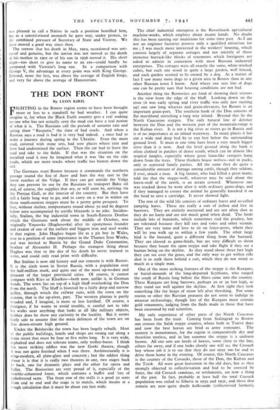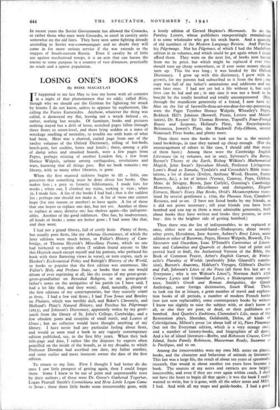THE DON FRONT
By LEON KIRIL FFIGHTING in the Rostov region seems to have been brought more or less to a standstill by bad weather. I can quite imagine it, for when the Black Earth country gets a real soaking no one who has not actually seen the mud can have a real notion of what it is. The Russians call the periods of autumn rain and spring thaw " Rasputie," the time of bad roads. And when a Russian says a road is bad it is very bad indeed. .t once had to make a' journey during spring in the Ukraine. Even the main road, covered with stone sets, had sore places where rain and frost had undermined the surface. Then the car had to leave the road and take to the fields. If that was the situation on the metalled road it may be imagined what it was like on the side roads, which are mere tracks where traffic has beaten down the soil.
The Germans want Rostov because it commands the northern passage round the Sea of Azov and bars the wag east to the lower reaches of the Volga. If they can get astride the Volga they can prevent its use by the Russians to transport Baku oil and, of course, the supplies that are, or will soon be, arriving via the Persian Gulf, to the interior of the country. But they have still a fairly long way to go, and to carry on a war in winter on those south-eastern steppes must be a pretty grim prospect. To face, without shelter, temperatures round abbut 5o and 6o degrees below zero accompanied by terrific blizzards is no joke. Inciden- tally, Stalino, the big industrial town in South-Eastern Donbas which the Germans took about the middle of October, was originally Yousovka (Hughesovka) after its eponymous founder and creator of one of the earliest and biggest iron and steel works in that region. John Hughes began life as a pit boy in Wales, rose to a position of some importance in the Thames Iron Works, and was invited to Russia by the Grand Duke Constantine, brother of Alexander II. Perhaps the strangest thing about Hughes was that to the day of his death he never learned to %%rite, and could only read print with difficulty.
But Stalino is now old history and our concern is with Rostov. It is the sixth town in Soviet Russia, with a population over the half-million mark, and quite one of the most up-to-date and pleasant of the larger provincial cities. Of course, it cannot compare with Kiev or Kharkov—both now, unlike it, in German hands. The town lies on top of a high bluff overlooking the Don from the north. The bluff is bisected by a fairly deep and narrow gulley, through which the railway runs, with the town on the eastern, that is the up-river, part. The western plateau is partly wooded and, I imagine, is more or less fortified. Of course, a foreigner, if he wants to avoid trouble, is careful not to take his walks near anything that looks at all like military objects, neither does he show any curiosity in the locality. But it seems fairly safe to assume that the main defences of the town are on this down-stream high ground.
Under the Bolsheviks the town has been largely rebuilt. Most of the public buildings, hotels and shops are strung out along a main street that must be four or five miles long. It is very wide, asphalted and does not tolerate trams, only trolley-buses. I think the most striking edifice was the new Gorki theatre, though it was not quite finished when I was there. Architecturally it is ultrA-modern, all plate-glass and concrete ; but the oddest thing about it is that it is really two theatres in one, two stages back to back, one for dramatic plays and the other for opera and ballet. The Rostovites are very proud of it, especially of the marble-columned foyer, which contains a buffet and lots of upholstered seats. The front row of the stalls is a good 5o seats from end to end and the stage is to match, which means at a rough calculation that it must be about too feet wide. The chief industrial enterprise is the Rosselmash agricultural machine-works, which employs about 20,000 hands. No doubt this has been turning out munitions for some time past. As I am not an engineer factories possess only a qualified attraction for me ; I was much more interested in the workers' housing, which consists largely of separate cottages and not entirely of those immense barrack-like blocks of tenements which foreigners are asked to admire in connexion with most Russian industrial enterprises. The cottages were all exactly the same, white-washed cubes, but each one stood in quite a large garden, well fenced, and each garden seemed to be owned by a dog. As a matter of fact I saw many more dogs to a given area in Rostov than in any other Russian town I know. And where one sees lots of dogs one can be pretty sure that housing conditions are not bad.
Another thing the Rostovites are fond of showing their visitors is the view from the edge of the bluff. Looking down on the river (it was early spring ancl river traffic was only just starting up) one saw long wharves and grain-elevators, for Rostov is an important grain-port. The southern bank of the Don consists of flat marshland stretching a long way inland. Beyond this lie the North Caucasian steppes. The only natural line of defence between the Don and the western part of the mountain-range is the Kuban river. It is not a big river as rivers go in Russia and is of no importance as an inland waterway. In many places it has cut a wide and deep bed 8o to too feet below the surrounding ground level. It must at one time have been a very much bigger river than it is now. And the level ground along the bank is often clothed in patches of dense scrub, which can be almost like tropical jungles, especially where great liana-like creepers hang down from the trees. These thickets house wolves—not in packs, only in scattered family parties. All the same they do quite a considerable amount of damage among cattle, though they seldom, if ever, attack a man. A big farmer, who had killed a great many, told me that the steppe-wolf, whatever may be said about the forest-wolf of the north, is an arrant coward. Whenever one was tracked down he went after it with ordinary game-dogs, and if they managed to corner the animal he generally knocked it on the head to save a cartridge. It never showed fight.
The rest of the wild life consists of ordinary hares and so-called jumping hares. These are really a sort of jerboa and live in burrows. They are entirely nocturnal and are not often shot as they do no harm and are not much good when dead. The birds include lots of buzzards, which sometimes raid the poultry, but are tolerated because they kill rats and voles and other vermin. They are very tame and love to sit on fence-posts, where they will let you walk up to within a few yards. The other large bird is the bustard, quite a different thing from the buzzard. They are classed as game-birds, but are very difficult to shoot because they haunt the open steppe and take flight if they see a human being on the skyline. As they stand about three feet high they can see over the grass, and the only way to get within rifle shot is to stalk them behind a cart, which they do not mind so much as a single man.
One of the more striking features of the steppe is the Kurgans, or burial-mounds of the long-departed Scythians, who ranged the south of Russia long before the Slays came into the country. These Kurgans are long barrows, perhaps zo or 3o feet high, so they stand out well against the skyline. At first sight they look something like the heaps of straw left after threshing. For some reason or other the Russian peasants do not seem to indulge in amateur archaeology, though lots of the Kurgans must contain gold ornaments, judging from the finds made in those that have been excavated by real scientists.
My only experience of other parts of the North Caucasus has been from the train. Coming from Stalingrad to Rostov one crosses the Salsk steppe country, where both in Tsarist days and now the best horses are bred as army remounts. The scenery is monotonous, for the region is comparatively dry and therefore treeless, and in late summer the steppe is a uniform brown. All one sees are herds of horses, some close to the line, others far away, and if one looks closely one will set the Cossack boy whose job it is to see that they do not stray too far and to drive them home in the evening. Of course, this North Caucasus is the country of the Cossacks, those of the Don, the Kuban and the Terek. All were great horsemen in the old days, but as they strongly objected to collectivisation and had to be coerced by force, the old Cossack stanitzas, or settlements, are now a thing of the past. In fact, probably at least half the total Cossack population was exiled to Siberia in 193o and 1931, and those that remain are now quite docile kolhozniki (collectivised farmers). In recent years the Soviet Government has allowed the Cossacks, or .rather those who once were Cossacks, to enrol in cavalry units somewhat on the old lines. They have seen some fighting already according to Soviet war-communtquis and no doubt they will come in for more serious service if the war extends to the steppes of South-eastern Russia. Even if cavalry be of little use against mechanised troops, it is an arm that can harass the enemy to some purpose in a country of vast -distances, practically no roads and a sparse population.























 Previous page
Previous page